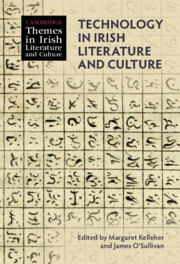Book contents
- Technology in Irish Literature and Culture
- Cambridge Themes in Irish Literature and Culture
- Technology in Irish Literature and Culture
- Copyright page
- Epigraph
- Contents
- Contributors
- Cambridge Themes in Irish Literature and Culture
- Acknowledgements
- Introduction
- Part I Genealogies
- Part II Infrastructures
- Part III Invention
- Chapter 8 Technology, Writing, and Place in Medieval Irish Literature
- Chapter 9 The Critique of Sola Scriptura in A Tale of a Tub and STEM in Gulliver’s Travels
- Chapter 10 Technology and Irish Modernism
- Chapter 11 W. B. Yeats, the Revival, and Scientific Invention
- Chapter 12 James Joyce, Irish Modernism, and Watch Technology
- Chapter 13 Technology, Terminology, and the Irish Language, Past and Present
- Part IV The Digital
- Index
- References
Chapter 13 - Technology, Terminology, and the Irish Language, Past and Present
from Part III - Invention
Published online by Cambridge University Press: 19 January 2023
- Technology in Irish Literature and Culture
- Cambridge Themes in Irish Literature and Culture
- Technology in Irish Literature and Culture
- Copyright page
- Epigraph
- Contents
- Contributors
- Cambridge Themes in Irish Literature and Culture
- Acknowledgements
- Introduction
- Part I Genealogies
- Part II Infrastructures
- Part III Invention
- Chapter 8 Technology, Writing, and Place in Medieval Irish Literature
- Chapter 9 The Critique of Sola Scriptura in A Tale of a Tub and STEM in Gulliver’s Travels
- Chapter 10 Technology and Irish Modernism
- Chapter 11 W. B. Yeats, the Revival, and Scientific Invention
- Chapter 12 James Joyce, Irish Modernism, and Watch Technology
- Chapter 13 Technology, Terminology, and the Irish Language, Past and Present
- Part IV The Digital
- Index
- References
Summary
New technologies inevitably require new terminology. To refer to rudders, spectacles, telephones, and more, over the centuries Irish speakers borrowed words from other languages as well as repurposing native terms. In recent times, the challenge posed by loanwords has been political as much as linguistic, but, while we cannot know how people of the Middle Ages felt about the inflow of words from Norse or Norman French, technological vocabulary probably tells the history of contact between the Irish and other cultures more clearly than any other word-field. Within Irish itself, terms for inventions and innovations serve as fascinating case studies in language change and resilience: some medieval words for still-common devices have inexplicably fallen out of use; some early terms have been recorded again after long periods of silence; some words have manifested twice, hundreds of years apart. This chapter charts the emergence and development of a selection of technological terms in both medieval and modern Irish.
- Type
- Chapter
- Information
- Technology in Irish Literature and Culture , pp. 217 - 232Publisher: Cambridge University PressPrint publication year: 2023



